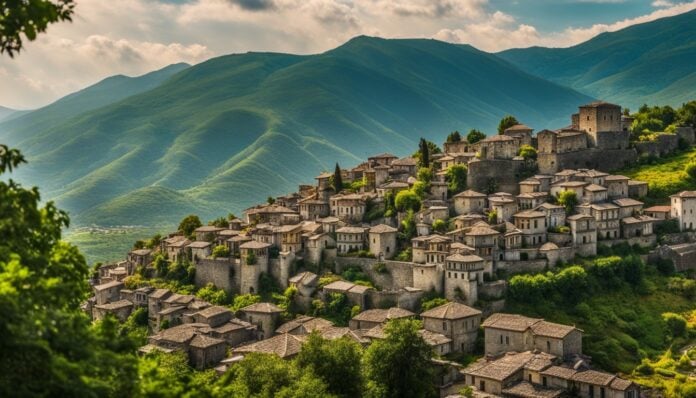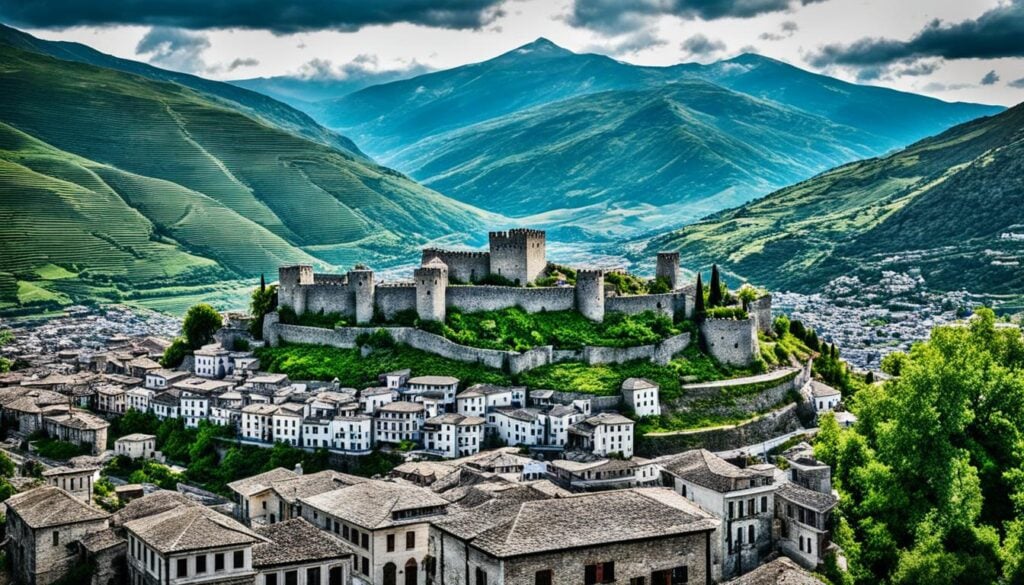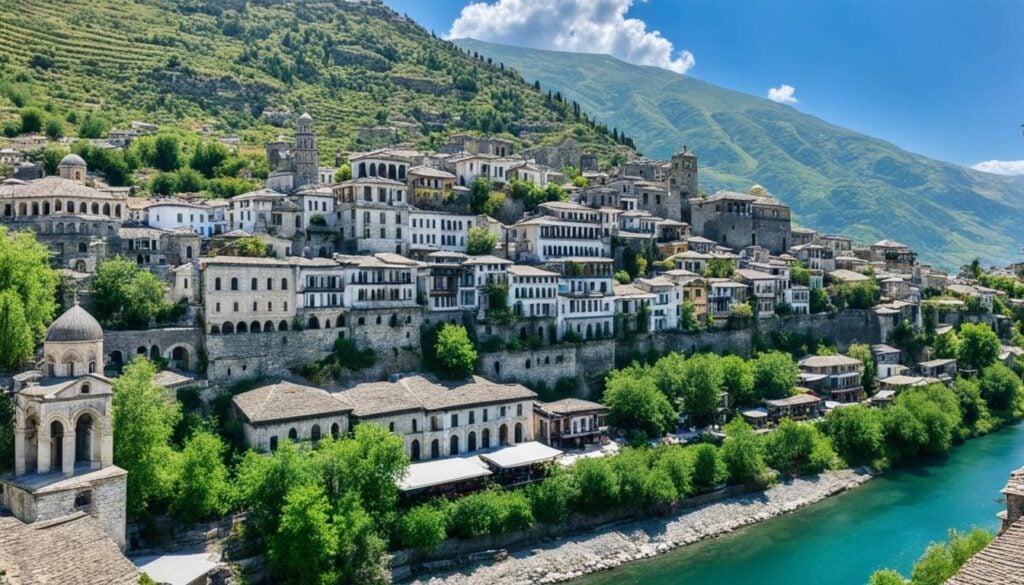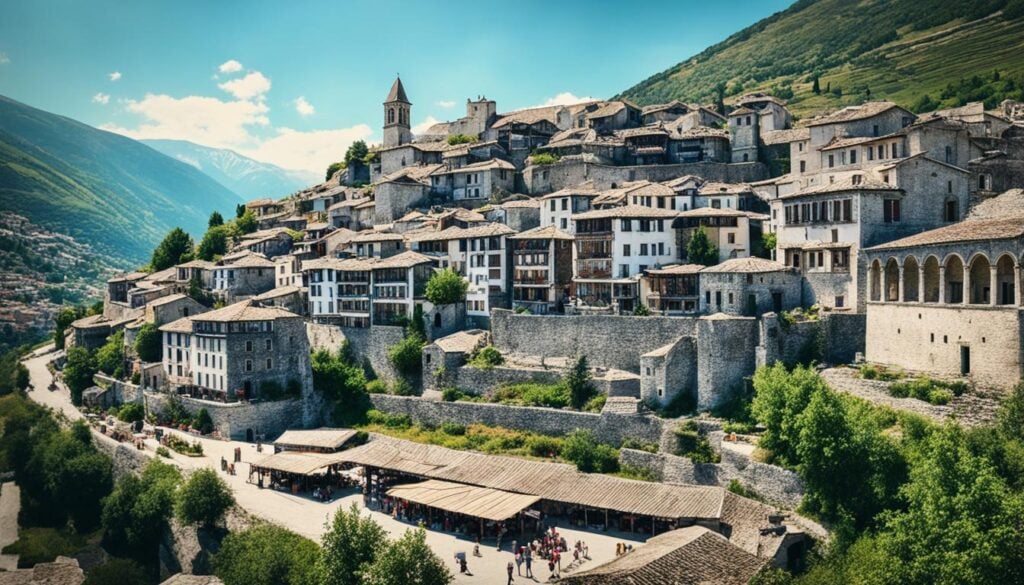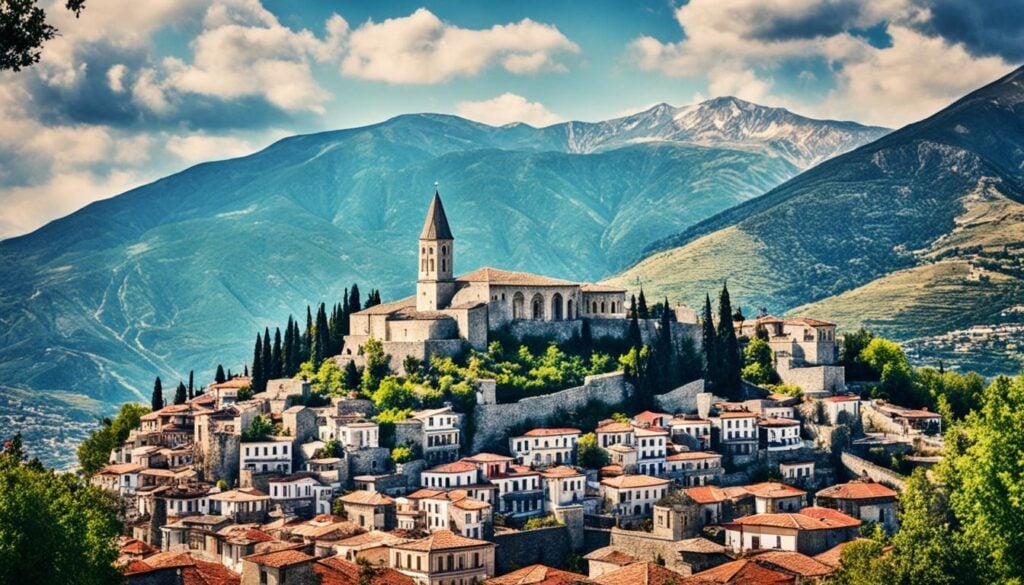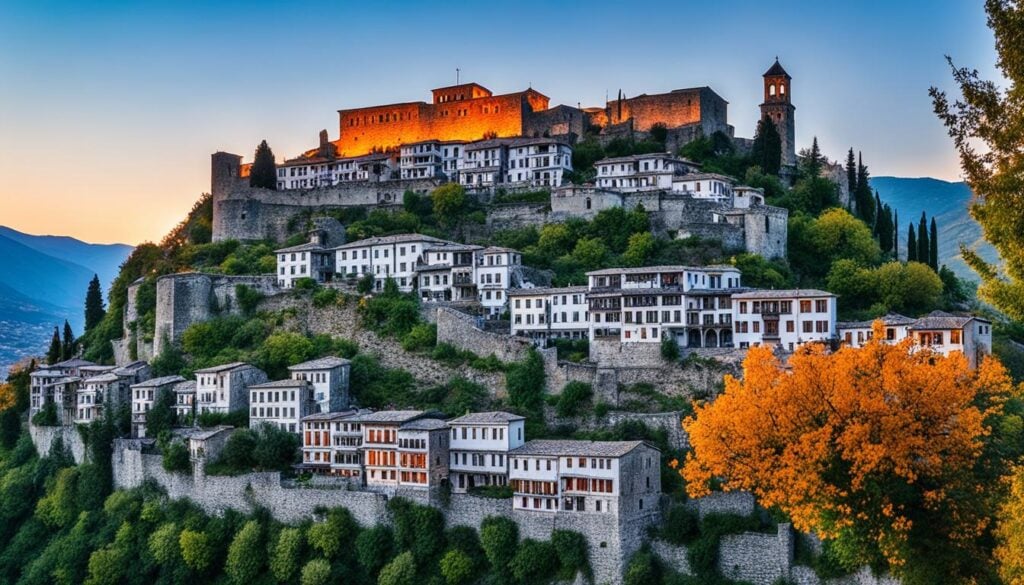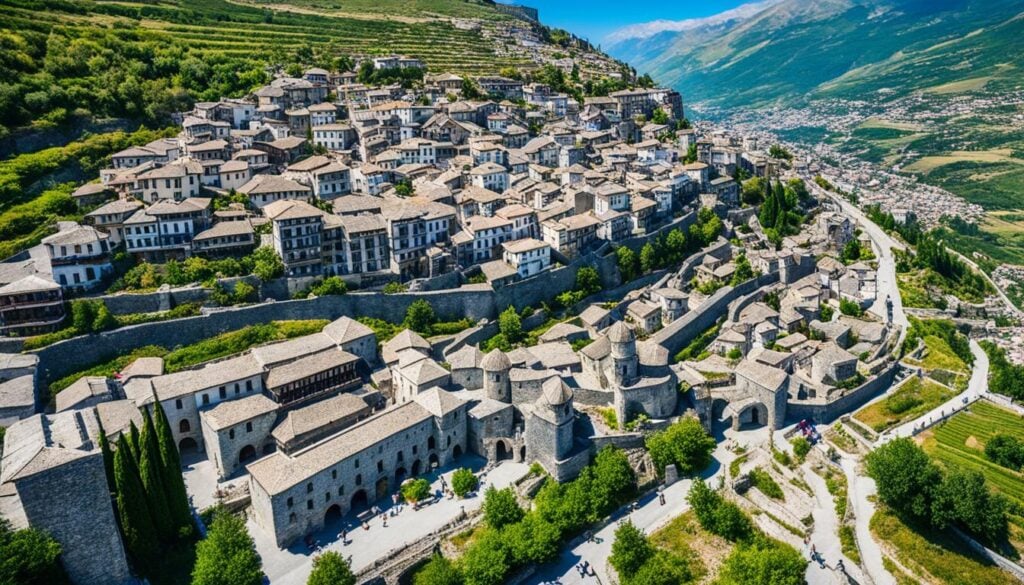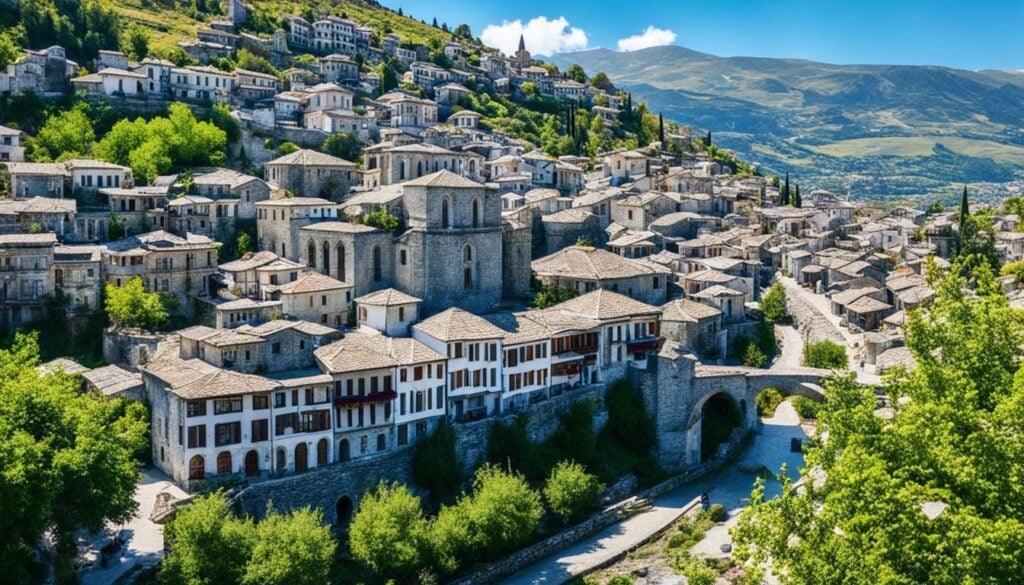Welcome to the fascinating Gjirokaster Stone City. It’s not just a city; it’s a treasure of history and astonishing architecture. Ever wondered how this place was built? What secrets lie in its ancient stones? Come with us as we dive into Gjirokaster’s past, watching it transform from a small village to a UNESCO World Heritage Site.
It started small, but Gjirokaster Stone City grew to be a key part of Ottoman architecture. It has seen centuries of history unfold. Its stone buildings carry stories of survival and sharing cultures. Journey with us as we discover the tales hidden in its famous stone walls.
And there’s a surprise. Gjirokaster is linked to the early life of a big leader. Guess who? Find out the unexpected tie between this beautiful city and Enver Hoxha. His story echoes significant events in Albania’s turbulent history.
Ready to explore the amazing history of Gjirokaster Stone City? Let’s uncover the old tales and secrets held in each stone. It’s time to dive into the past and experience something unforgettable.
Come with us to discover Gjirokaster Stone City’s mystery. We’ll learn about its importance and incredible architecture. Follow us as we walk through history, highlighting the path to keep this heritage alive for the future.
The Origins of Gjirokaster Stone City
To grasp the breathtaking beauty and design of Gjirokaster Stone City, we must understand its beginning. The stunning Gjirokaster Castle stands at its heart. It shaped the area’s growth and story over the years.
Gjirokaster Castle was first built in the 12th century. It shows the deep history of the city. Sitting high on a hill, it looks over the charming stone houses below, creating a scene from another time.
Walking through Gjirokaster Stone City, you’ll be amazed by the craft in its stone buildings. The houses, with their wooden balconies and colorful fronts, mix Ottoman, Balkan, and Byzantine styles well.
The castle was in a key spot, making it important in many fights and power shifts. From Ottomans to Enver Hoxha, these stories are now part of the city’s beauty. It stands strong as a symbol of lasting through hard times.
Today, Gjirokaster is alive with its past, drawing tourists eager to see its beauty. It’s both a UNESCO Heritage site and a lively mix of Ottoman and Albanian culture. This mix, along with its old buildings, makes it a special trip to history.
Strolling down its old roads, you’ll be caught up in the tales of this city. From legends like Ali Pasha to its own cultural celebrations, Gjirokaster soaks you in history with every step.
The Origins of Gjirokaster Stone City – Key Highlights
| Key Highlights | Description |
|---|---|
| Gjirokaster Castle | The 12th-century fortress that influenced the city’s development. |
| Merging Architectural Styles | The harmonious blend of Ottoman, Balkan, and Byzantine influences in the city’s stone houses. |
| Historical Significance | The city’s role in the region’s history, from conflicts to changing rulers. |
| UNESCO World Heritage Site | Gjirokaster Stone City’s recognition for its historical and cultural importance. |
| Tourist Destination | The vibrant appeal of Gjirokaster Stone City as a popular tourist attraction. |
Ottoman Influence on Gjirokaster Stone City
Gjirokaster Stone City boasts a rich mix of architectural styles. It reflects the influence of many eras. However, the Ottoman Empire had a lasting impact.
The Ottoman Empire’s architecture is both grand and intricate. In Gjirokaster, you can see this in the city’s stone structures. They blend Ottoman design beautifully with local styles.
Ottoman buildings in Gjirokaster fit in perfectly with their environment. They are known for their strong construction and fine details. This shows the empire’s focus on both durability and beauty.
These structures include unique elements like elaborate arches and detailed woodwork. They show how Ottoman and Albanian influences merged. This fusion makes Gjirokaster a special place to visit.
The Ottoman influence in Gjirokaster goes beyond just buildings. It also affects the city’s layout. The Ottomans designed spaces that bring people together, like interconnected streets and plazas. This helped create a strong sense of community.
Walking through Gjirokaster Stone City, you find many Ottoman design treasures. From the elegance of Gjirokaster Castle to detailed Ottoman homes, each place has a story to tell. It shows us the beauty of Ottoman design mixed with the city’s stone structures.
Gjirokaster Stone City during Enver Hoxha’s Era
Enver Hoxha was a key figure in Albanian history, born in Gjirokaster Stone City. His birthplace is important for the city and the entire country. Under Hoxha’s rule, the city saw many changes that affected its look and buildings.
From 1944 to 1985, Hoxha’s communist government shaped Gjirokaster. It became a place for politics and strict rules. Gjirokaster Stone City was turned into a guarded area with extreme security. Its high position was perfect for overseeing the people.
Hoxha’s influence can be seen in the city’s building styles. During his time, the city was rebuilt with new, powerful-looking buildings. Central structures, like the Palace of Culture, showed off the government’s control. Even old Ottoman houses were used for new government purposes.
While Hoxha tried to change the city, it kept its old traditions too. The medieval castle above Gjirokaster remained, showing the city’s fight to stay as it was. Many old buildings kept their unique look despite new uses.
Hoxha’s rule also meant isolation and strict control, making Albania very closed off. Gjirokaster felt this lack of connection with the rest of the world. But, this helped keep its old ways and slowed modern changes.
Now, as Albania moves forward, Gjirokaster Stone City shows a part of that history. It tells the story of how people kept their ways during hard times. The city is a symbol of strength and tradition.
Next, we will look at why Gjirokaster Stone City is so special as a UNESCO World Heritage Site.
Gjirokaster Stone City’s UNESCO World Heritage Status
Gjirokaster Stone City is a part of the prestigious UNESCO World Heritage Sites. It has been marked for its cultural and architectural importance. Its inclusion tells us about its deep historical value and its global significance for all people.
In 2005, it was named a UNESCO World Heritage Site. This recognition is due to its unique architecture that mixes various cultural styles. The city’s Old Town area is especially rich, showing off its Ottoman-era buildings and old streets.
This status shows us how important Gjirokaster Stone City is. It’s like a living history book, connecting us with the past. For visitors, it’s a chance to dive into the city’s culture and history firsthand.
Being a UNESCO World Heritage Site comes with a duty to protect its treasures. There are strong efforts to keep its historic buildings, crafts, and cultural practices. Many projects aim to keep the city’s charm and history alive for the future.
| Criteria for World Heritage listing | Description |
|---|---|
| Criterion ii: | Gjirokaster Stone City exhibits an important interchange of human values, bearing exceptional testimony to a cultural tradition or civilization that is still living today. |
| Criterion iv: | The architectural ensemble of Gjirokaster Stone City represents an outstanding example of a type of building, architectural, or technological ensemble or landscape that illustrates a significant stage in human history. |
| Criterion v: | Gjirokaster Stone City represents an outstanding landscape that combines extraordinary natural beauty with historical, artistic, and cultural values. |
This UNESCO title has brought more visitors to the area. It’s not just tourists who come, but people eager to learn about its unique heritage. Thanks to the UNESCO recognition, Gjirokaster is now buzzing with people keen on its architecture, culture, and history.
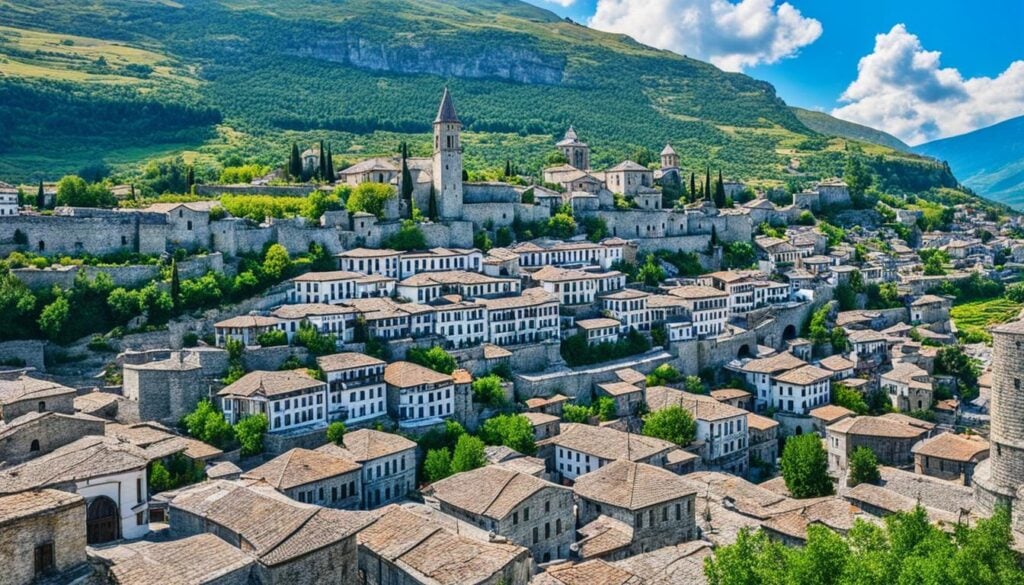
Keeping its UNESCO status is vital for Gjirokaster Stone City’s future. It helps with its ongoing care and ensures it’s here for younger generations to love. By protecting its heritage, we make sure its story continues to inspire and touch people’s hearts around the world.
The Influence of Ali Pasha of Tepelena
Ali Pasha of Tepelena was a strong figure in Albanian history. His work greatly impacted Gjirokaster Stone City. He is remembered for his leadership and the way he improved the city’s look and culture.
Architectural Contributions
Ali Pasha didn’t just govern; he also designed and repaired buildings. This left a beautiful mark on the city. His support helped create impressive buildings. They show his love for beauty and fancy things.
The Ali Pasha Castle, for example, shows his style. It was both a strong building and a sign of his power. This castle mixes both Ottoman and European styles. It shows how different cultures came together under Ali Pasha’s rule.
He also had mosques and public buildings made. These places were decorated with care. They mix Islamic and Albanian styles beautifully.
Cultural Impact
Ali Pasha did a lot for Gjirokaster’s culture too. He helped artists and writers. This brought lots of smart and talented people to the city.
The city became a place for learning and creativity thanks to him. Many important people in culture and thought lived there. It was a time when the city really shined in art and ideas.
Legacy and Influence
Ali Pasha’s impact is still felt today in Gjirokaster Stone City. Despite being a controversial leader, he forever changed the city for the better.
Now, visitors can see his buildings and feel the culture he supported. Ali Pasha’s legacy is a mix of many influences. It’s what makes Gjirokaster Stone City a special place.
Exploring the Architectural Marvels of Gjirokaster Stone City
Walking through Gjirokaster Stone City is like going back in time. You’ll see beautiful stone buildings all around you. They are part of a UNESCO World Heritage site. Each building has its own history, showing off Gjirokaster’s past and cultural mix.
Gjirokaster’s buildings mix Ottoman, Greek, and medieval styles. This blend makes the city truly special.
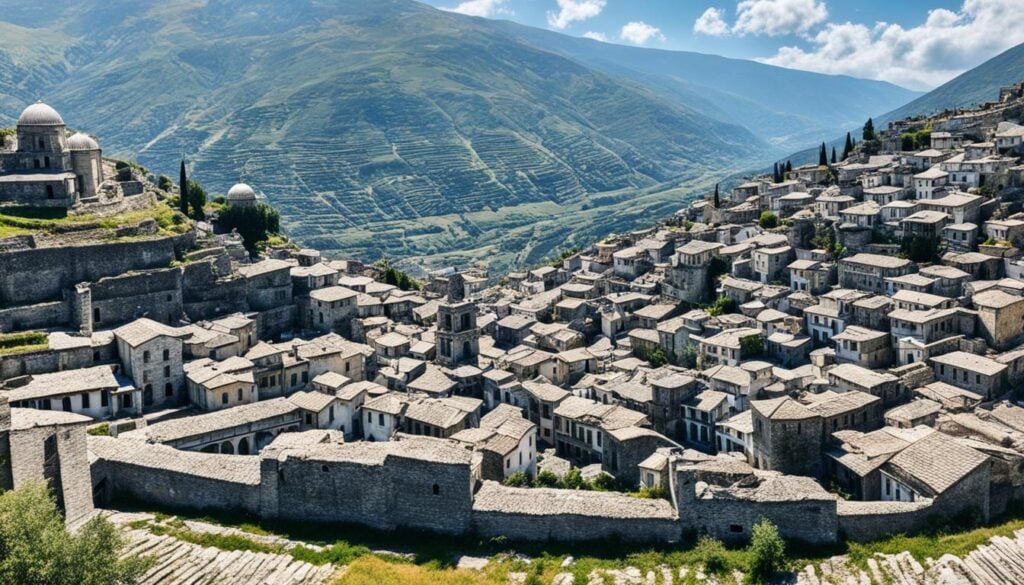
The Stone Buildings of Gjirokaster
The stone buildings are key to Gjirokaster’s look. They’re made from local limestone. Gjirokaster’s craftsmen created these buildings over many years. From big mansions to small cobblestone streets, each one is unique.
Exquisite Details and Design
The buildings in Gjirokaster are not simple. They are full of beautiful details. Look for carvings, balconies, and arches. These features make every building special.
Each building reflects different times and styles, adding to Gjirokaster’s charm.
Historical Significance
The buildings aren’t just pretty; they’re also full of history. They tell stories of the people who lived there. For example, the Zekate House shows Ottoman traditions.
The Gjirokaster Castle is a sign of the city’s strength. Every building is a piece of history.
Preserving Gjirokaster’s Architectural Heritage
Groups like the Gjirokaster National Museum protect these buildings. They work hard to keep Gjirokaster’s history alive. This is for everyone, including future generations.
Experience the Timeless Beauty
Visiting Gjirokaster is special. You get to see its historic beauty up close. Just walking around is a magical experience.
If you’re in Albania, don’t miss Gjirokaster. Its stone city is a must-see for anyone. You’ll be amazed by its beauty and history.
Gjirokaster Stone City’s Cultural Significance
Gjirokaster Stone City isn’t just a bunch of cool stone buildings in Albania. It’s filled with deep cultural meaning that touches both locals and visitors. Let’s dive into how it’s kept the Albanian culture and heritage alive over time.
One reason Gjirokaster Stone City is so culturally important is its impact on arts and literature. It has inspired many artists, writers, and poets for centuries. The unique stone buildings there have sparked creativity and served as backdrops for art.
Authors like Ismail Kadare show the city’s literary influence in their work. Kadare, a nominee for the Nobel Prize in Literature, often mentions the city’s unique charm. He weaves its captivating architecture into his stories, celebrating Gjirokaster’s essence through his writing.
This place is more than just art and writing, though. It’s deeply connected to local traditions, too. Gjirokaster Stone City helps keep Albanian customs alive. It stands as a proud symbol of the nation’s rich cultural heritage.
As a living piece of history, Gjirokaster Stone City acts like a museum of old Albanian life. Here, visitors can dive into the local culture by enjoying music, dance, and stories. The historic spots, like Gjirokaster Castle, let us peek into the past lives of the people there.
In 2005, this city was honored as a UNESCO World Heritage site. This title recognizes the importance of preserving both its unique architecture and cultural value. It shows the world just how special Gjirokaster Stone City really is.
Gjirokaster Stone City’s Cultural Significance in Numbers:
| Year | Number of Visitors |
|---|---|
| 2015 | 150,000 |
| 2016 | 180,000 |
| 2017 | 210,000 |
Looking at the table, we see more and more people are visiting Gjirokaster Stone City every year. The growing interest reflects its worldwide cultural importance.
Visiting here means stepping into the heart of Albanian culture. It’s not just about ancient architecture. It’s a place that tells the evergreen story of a whole nation. Whether you love art, history, or new adventures, Gjirokaster Stone City will win you over. It’s a visit that will stay with you for a long time.
The Evolution of Gjirokaster Stone City’s Tourism
Gjirokaster Stone City in Albania is famous for its historic stone buildings. Over the years, its tourism has grown a lot, bringing in visitors from worldwide. The city is loved for its rich history, beautiful architecture, and cultural activities.
The Gjirokaster Castle is a major attraction, sitting on a hill above the city. Built in the 12th century, it offers stunning views and a look into the city’s past. Visitors can walk its ancient halls, see its grand design, and learn about its history.
There are many other remarkable buildings in the city besides the castle. These Ottoman-style structures are full of character and charm. A stroll through the city’s streets is a step into the past. You can see the detailed carvings, tour old museums, and absorb the local culture.
The city’s rise in tourism benefits from work to keep and promote its unique heritage. As a UNESCO World Heritage site, this recognition encourages more sustainable tourism. It highlights Gjirokaster Stone City’s cultural and historical value.
Tourism growth has led to more places to stay, eat, and enjoy the city’s offerings. Local businesses have seized this chance to share the city’s special charms. This has made visiting the city even better.
| Reasons for Gjirokaster Stone City’s Popularity | Impact on Tourism |
|---|---|
| Historical significance | Increase in heritage tourism |
| Unique architectural attractions | Growth in cultural tourism |
| UNESCO World Heritage status | Boost in international recognition and visitor numbers |
| Preservation and promotion efforts | Improved visitor experience and sustainable tourism practices |
The city’s tourism growth has brought economic and cultural advantages. Visitors learn to appreciate Gjirokaster’s history and culture. This ensures the city’s beauty and history are cherished by future generations.
Preserving and Promoting Gjirokaster Stone City’s Heritage
Gjirokaster Stone City is famous for its ancient stone buildings and rich past. Local groups and officials work hard to protect and celebrate its unique history. They aim to keep the area’s beauty for visitors but also to maintain its essence for those who live there.
To keep Gjirokaster’s stone structures alive, experts carefully restore them. They focus on keeping everything true to its original form. These experts, using old-fashioned techniques, help Gjirokaster maintain its time-honored look. This gives visitors a special glimpse into history when they visit.
“The stone buildings of Gjirokaster stand as a testament to the city’s rich cultural heritage. Our aim is not only to restore and preserve these structures but also to educate visitors about their historical and architectural importance,” says Maria Petrova, the Director of Gjirokaster Stone City Preservation Society.
Boosting tourism also aids in preserving Gjirokaster’s heritage. The city teamed up with cultural groups and guides. Together, they developed ways to show tourists Gjirokaster’s unique beauty and history. This includes tours led by locals who know the city inside out.
The local tourism board in Gjirokaster works to highlight the area’s crafts and customs, too. Programs like craft workshops aim to connect visitors with Gjirokaster’s traditions. By involving locals, these activities also help support the community and its heritage.
Revitalizing Gjirokaster Stone City’s economy through tourism
Gjirokaster Stone City’s economy benefits a lot from tourism. By encouraging respectful tourism, the city hopes to draw visitors who love its special features. The funds from tourism help local businesses and support efforts to preserve the city’s historical sites.
But, as more tourists come, there’s a need to balance progress with historical preservation. Local leaders and groups work hard to ensure any new additions respect the area’s old charm. Their goal is for Gjirokaster to keep its beauty and history for those who’ll come in the future.
| Preservation Efforts | Promotion Initiatives |
|---|---|
| Restoration and maintenance of stone buildings | Guided tours showcasing the city’s history and architecture |
| Skilled craftsmen utilizing traditional stone masonry techniques | Workshops on traditional crafts and cultural traditions |
| Collaboration with cultural organizations and tour operators | Showcasing traditional music and folklore |
Conclusion
Gjirokaster Stone City shows the peak of Albania’s history and culture. This city’s stunning stone buildings, influenced by Ottoman style, are shaped by its rich past. It’s now a UNESCO World Heritage Site and a top pick for tourists.
With careful care and promotion, Gjirokaster Stone City still amazes visitors. It gives everyone a peek into its intriguing history.

































